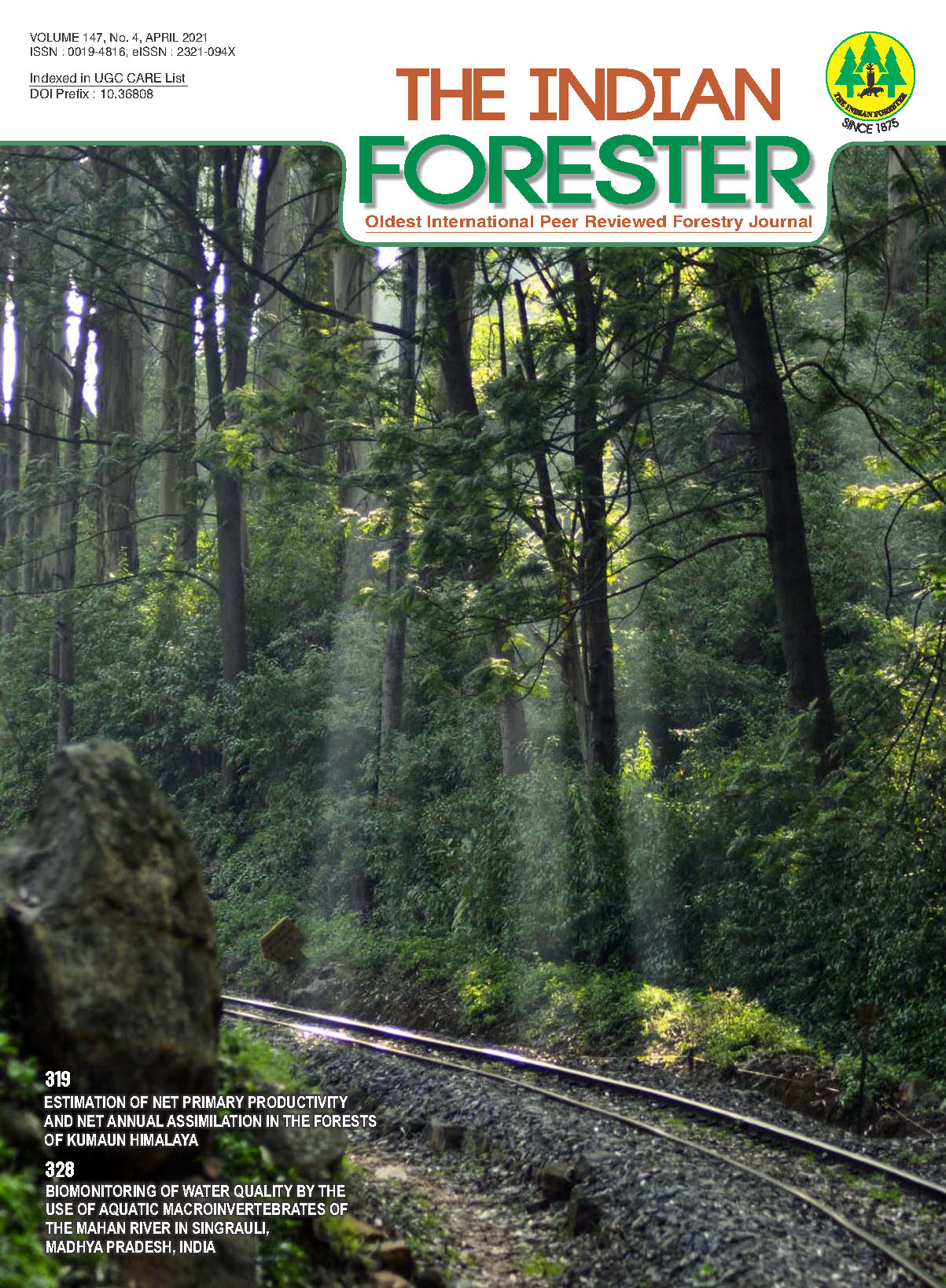Estimates of Components of Variance, Genetic Gain and Heritability for Growth, Physiological and Biochemical Traits of Casuarina Clones under Varying Levels of Salinity Stress
DOI:
https://doi.org/10.36808/if/2021/v147i4/156391Keywords:
Genetic Gain, Heritability, Variation, Casuarina, Saline Water.Abstract
Eight clones of Casuarina (four of Casuarina junghuhniana and four of inter-specific hybrids of Casuarina equisetifolia × C. junghuhniana) were subjected to saline water irrigation with different concentrations of NaCl viz., 0, 40, 80 and 120 mM. After twelve months of study period, significant genetic variability was observed among clones for growth, physiological and biochemical traits. High estimates of heritability with reasonable genetic advance were observed for plant height, collar diameter, plant fresh weight, plant dry weight and root length. Increase in genetic advance with increase in salinity levels (with highest genetic advance at 120 mM NaCl) coupled with high heritability estimates for all the characters suggested the potentiality of clonal material for improvement through selection for planting under saline soils.References
Allen J.A., Chambers J.L. and Stine M. (1994). Prospects for increasing the salt tolerance of forest trees a review. Tree Physiology, 14: 843-853.
Anon. (2013). Annual Report (2013) of Central Soil Salinity Research Institute, Karnal, Haryana, India.
Bassi P., Garg R.K., Choudhary O.P. and Kaur N. (2020). Effect of salinity stress on growth related physiological and biochemical traits of Casuarina clones in nursery. Indian J. Agroforestry, 22(1): 90-96.
Bates L.S., Waldren R.P. and Tears I.D. (1973). Rapid determination of free proline for water stress studies. Plant and Soil, 39: 205-207.
Burton G.W. (1952). Quantitative inheritance in grasses. 7th Proceedings of International Grassland Congress. 1: 277 283.
Deshmukh S., Sairam R.K. and Shukla D.S. (1991). Measurement of ion leakage as a screening technique for drought resistance in wheat genotypes. Indian Journal of Plant Physiology, 34: 89-91.
Devagiri G.M., R.C. Dhiman, R.C. Thapliyal, C.S.P. Patil and N. Kumar. (2004). Genetic analysis of traits related to seed germination and vigour among provenances of shisham (Dalbegia sissoo Roxb.). Annals of Forestry 122: 161-171.
Dorman K.W. (1976). The Genetics and Breeding of Southern Pines. Agriculture Handbook No. 471. USDA, US Forest Service, Washington, D.C.
Dubois M., Giles K.A., Hamilton J.K., Reters P.A. and Smith F. (1956). Calorimetric method for the determination of sugars and related substances. Annal Chem., 28: 350-56.
Duncan D.B. (1955). Multiple range and multiple F tests. Biometrics, 11(1): 1-42.
Garg R.K., Yadav R.K., Sheoran P., Kumar A., Narjary B., Meena M.D. and Sharma D.K. (2017). Enhancing productivity potential of saline soil through agroforestry system using saline irrigation. Indian Forester, 143(9): 856-861.
Geranpaeieh A., Azizpour K., Vojodil L. and Valizadeh R. (2014). The effects of salinity on some physiological traits of Lepidium sativum. In: The Second National Congress on Agricultural New Findings, Tehran, Iran.
Ghoulam C., Foursy A. and Fares K. (2002). Effects of salt stress on growth, inorganic ions and proline accumulation in relation to osmotic adjustment in five sugar beet cultivars. Environmental and Experimental Botany, 47: 39-50.
Glenn E.P. and Brown J.J. (1998). Effects of soil salt levels on the growth and water use efficiency of Atriplex canescens (Chenopodiaceae) varieties in drying soil. American Journal of Botany, 85: 10-16.
Greenway H. and Munns R. (1980). Mechanisms of salt tolerance in nonhalophytes. Annual Review of Plant Physiology, 31(1): 149-190.
Hasegawa P.M., Bressan R.A., Zhu J.K. and Bohnert H.J. (2000). Plant cellular and molecular responses to high salinity. Annual Review of Plant Biology, 51(1): 463-499.
Johnson H.W., Robinson H.F. and Comstock R.E. (1955). Estimates of genetic and environmental variability in soybean. Agronomy Journal, 47: 314-318.
Kaushik N., S. Kumar, K. Kumar, R.S. Beniwal, N. Kaushik and S. Roy. (2007). Genetic variability and association studies in pod and seed traits of Pongamia pinnata (L.) Pierre in Haryana, India. Genet Resouur Crop Evol., 54: 1827 1832.
Kaushik N., S. Mann and K. Kumar. (2011). Variability in growth characters among progenies of Pongamia pinnata (L) Pierre. Range Mgmt. and Agroforestry 32: 131-134.
Kumar R. (2012). Genetic variability and association studies in Pongamia pinnata (L.) Pierre. Range Mgt Agrofor., 33(2): 129-132.
Kumar R. (2014). Seed source variation and character association studies for seed and seedling traits in Pongamia pinnata (L.) Pierre. Indian Jo For., 37(3): 255-258.
Kumar R., K.S. Bangarwa and R.C. Verma. (2007). Genetic variability among different Eucalyptus tereticornis clones. Annals of Forestry, 15(2): 201-206.
Lush J.L. (1949). Heritability of quantitative characters in farm animals. Hereditas, 35: 356-357.
Shen X., Castle W.S. and Gmitter Jr., F.J. (2009). Micropropagation of a Casuarina hybrid (Casuarina equisetifolia L. × Casuarina glauca Sieber ex Spreng) following facilitated seed germination. Plant Cell Tissue and Organ Culture, 97(1): 103-108.
Zahran H.H. (1999). Rhizobium-legume symbiosis and nitrogen fixation under severe conditions and in an arid climate. Microbiology and Molecular Biology Reviews, 63(4): 968-989.
Zobel B.J. (1971). The genetic improvement of southern pines. Sci. Amer. 225: 94-103.
Downloads
Downloads
Published
How to Cite
Issue
Section
License
Unless otherwise stated, copyright or similar rights in all materials presented on the site, including graphical images, are owned by Indian Forester.





